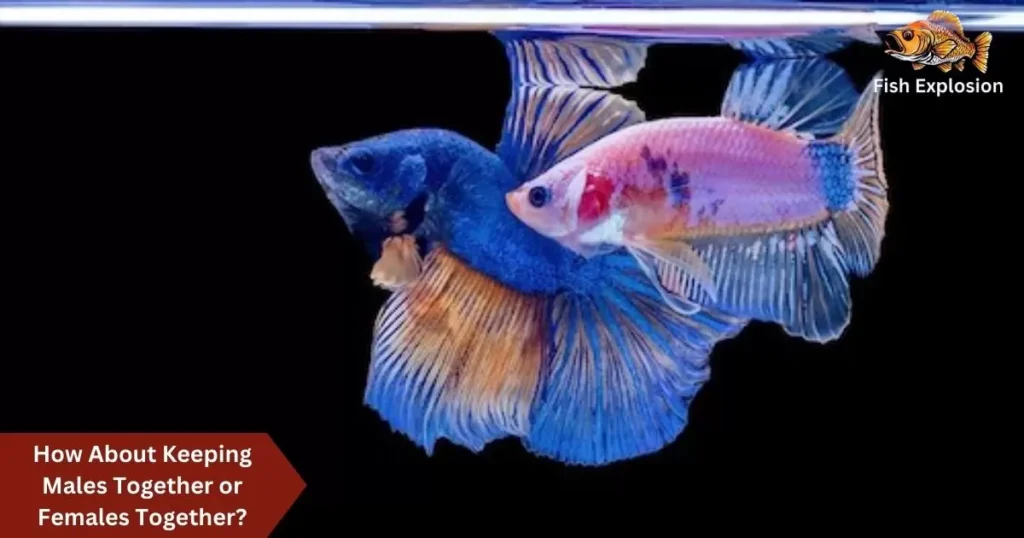While male and female bettas can be housed together temporarily for breeding purposes, it is generally not recommended to keep them together outside of breeding. Male bettas are extremely territorial and aggressive towards other bettas, especially other males that enter their territory. Even females may clash on occasion. If housed together outside of breeding, the bettas are likely to fight and nip fins, causing stress and potential illness or injury. The safest option is to house male and female bettas separately, in different tanks some distance away from each other to avoid conflict and fighting between the incompatible fish.
The Short Answer
Let’s start with the short answer: no, you can’t keep male and female betta fish together permanently.
Bettas are incredibly territorial fish, especially the males. If two males are housed together, they will almost certainly fight. Their colorful fins and tails evolved for attracting mates and dominating rivals, so they simply cannot tolerate another male in their space. Left together long term, they may seriously injure or even kill one another.
Even a male and female pair should not be housed together long term. While males may tolerate females during breeding, outside of that, they will still attack and chase the female, seeing her as an intruder in his tank. The stress of constant harassment is detrimental to the health of the female betta.
There is one exception – breeding. When introducing a ready-to-breed female to a male’s tank, the pairing may temporarily coexist long enough to spawn. However, the male must be removed immediately afterward to prevent further fighting.
In general, bettas are not community fish. Their aggression makes cohabiting very difficult, even with a male-female pair. For the well-being and safety of all bettas involved, the best option is to house them singly, in separate tanks some distance apart, with only supervised breeding encounters. This prevents conflict and injury between these gorgeous but pugnacious fish.
Read More: “How To Know If Molly Fish Is Pregnant?”
Betta Behavior
Boy, betta fish sure do have attitude, don’t they? These little guys really know how to make their presence known. They’re always flaring their gills out and showing off those bright colorful fins like they own the place.
And most of the time, it’s the males doing all the strutting too. They’ll chase off any other bettas that get too close, even the females sometimes. It’s like they’re always trying to prove they’re number one.
If you put two male bettas together, you’re definitely going to see some fireworks as they butt fins and nip at each other to settle the score of who’s top dog.
Even just being able to see their own reflection is enough to make some bettas blow their stack. These pint-sized pugilists have a lot of spunk in that tiny body of theirs.
Their feisty nature is part of what makes them such flashy aquarium stars, that’s for sure.
Bettas in The Wild
Despite their reputation as aggressive fighters, bettas actually live peaceful lives in the rice paddies and slow-moving streams of Southeast Asia. In the wild, they dwell among dense tropical vegetation and enjoy warm, oxygen-rich water.
Male bettas use their vibrant colors and fins to attract mates, not battle rivals. Only during breeding season do they briefly flaunt and flare at competing males vying for females.
Breeding Behavior
- Males build bubble nests near the surface of the water in preparation for eggs. They blow tiny bubbles that connect into a nest structure.
- When introducing a mature female, the male will flare his fins, elongate his colorful fins, and flare his gills to entice her into his nesting area.
- If receptive, the female will swim back and forth while the male follows. They will vibrate fins and bodies in a spawning embrace before releasing eggs and sperm into the nest.
- The male then chases the female away from the nest as he stands guard over the eggs. He will remain to tend and protect the eggs until they hatch.
- Within 2-3 days, fry (baby bettas) will hatch from the eggs. For several days, the male continues protecting them from predators by herding them into the nest for safety.
Betta’s Behavior in Captivity
Bettas taken from their natural habitat and kept as pets often display more intense territorial and aggressive behavior than their wild counterparts. In a small glass tank without enough hiding spaces or tankmates, males, in particular, can become stressed and attack their own reflection. Proper care and tank setup are important to encourage exploratory behavior rather than constant battling with perceived intruders.
What About for Breeding?
So you’re thinking of trying your hand at breeding betta fish, eh? Good for you for wanting to learn the ins and outs of how to raise those cute little babies. Just know that it’s definitely different than keeping them as pets. For one, you’ll need a whole separate breeding tank since you can’t keep Momma and Poppa in the same water permanently.
And you gotta let the magic happen too – give them some privacy till the deed is done! Once you’ve got the eggs, it gets even more involved since Daddy Betta will watch over them like a hawk.
I can’t even imagine how many tiny bubble nests you’d end up with if you bred a whole bunch at once. Kudos to anyone with the patience for that kind of project. Just take it slow at first so you don’t get in over your head with a ton of loose fry to care for. But if you’re up for the challenge, betta breeding can be really rewarding too.
How Can You Introduce Bettas to One Another for Breeding?

The key to introducing bettas for breeding is to do so slowly and carefully in order to minimize aggression and fighting. Start by placing the female in a separate floating container within the male’s tank for a few hours so they can see each other but not physically interact.
This allows them to size each other up without risk of injury. Increase contact over multiple sessions by raising and lowering the female’s container. When she shows no fear response, you can release her into the tank while continuing to supervise closely.
The male may flare initially but should not chase or nip if introduced properly. Have breeding tanks ready so you can separate them immediately at the first signs of real aggression. With patience and by giving them control over the pacing of interactions, you can set your bettas up for a successful spawn.
Can Bettas Be Kept Together if You Really Have To?
While bettas are generally not compatible tankmates due to their territorial nature, there are some measures you can take if temporarily housing two together becomes unavoidable.
Maintain the tank at 5 gallons or larger with dense live or silk plant coverage to break lines of sight and provide hides.
Introduce only one fish, either a lone male or female, at a time to the established tank. Supervise interactions closely and be prepared to separate immediately if any aggression is observed. Nipped fins or other signs of stress suggest the situation needs rehoming.
Smaller tanks increase confrontations, so only attempt this setup as a short-term solution. Even with precautions, conflicts may still occur since bettas prefer solitary accommodation. It is best avoided if alternative housing arrangements can be made.
How About Keeping Males Together or Females Together?

- Males will almost always fight, even potentially fatally, if housed together permanently.
- Females have a slightly better chance but still require individual tanks for long-term care.
- Bettas lack shoaling instincts and prefer to be the sole residents of their territory.
- Aggression comes from their natural instincts to claim space and compete for mates.
- Housing must provide multiple clear line-of-sight breaks and hiding spots.
- Maintain at minimum a 20 gallon tank with lots of plants and decor if attempting.
- Monitor for stress signals, like clamped fins or redness, that suggest conflict.
- Consider only keeping a mated male-female pair during the breeding season.
- Sororities of 6+ females can sometimes work in a well-established planting-filled tank.
- Most bettas still do best in individual 5+ gallon housing though, for reduced conflict.
How to Tell if Betta is Male or Female?
There are a few key differences to examine when trying to determine the sex of a betta fish. Males will generally have larger, more brightly colored fins and tails, as well as a thicker body shape. Females have thinner, shorter fins that are usually duller in color.
The underside of the male betta is pointed while the female has a rounded belly. When viewed from above, males have an oval-shaped gonopodium near the anal fin that is used for fertilization, while females have a slit.
It’s best to look at the fish from both top and bottom views. With young juvenile bettas, identifying sex can be difficult but become clearer as they mature over months. An experienced eye or using a magnifier can help confirm male vs female features.
Can Bettas Be Kept with Other Fish

While bettas are known to be aggressive fish, there are a few species they can sometimes tolerate as tankmates if proper conditions are met. The most compatible options include peaceful community fish like pygmy cories, otocinclus catfish, neocaridina shrimp, and some smaller peaceful tetra or barb species.
However, bettas still must be introduced carefully and supervised closely. Their tank must be heavily planted with hiding spaces and at least 5 gallons per betta. Even then, there is risk of fin-nipping or chasing. Water parameters must also be suitable for all inhabitants.
Ultimately, housing bettas alone is best to avoid conflicts. Only attempt community tanks if you can provide a well-established environment meeting each species’ needs without compromise. Frequent monitoring is required to move any fish struggling with aggression.
Best to Keep Them Separate – Apart from Romantic Encounters
While bettas may tolerate brief contact to breed, housing them permanently together poses too many risks to their health and well-being. Separateaccommodations are preferable except for controlled spawnings.
- Bettas are not schooling fish and prefer solitary living spaces.
- They can harass and injure tankmates through fin-nipping or chasing.
- Tank size must be significantly larger with lots of plants when attempting a sorority or community.
- Stress from aggression compromises their immune system andquality of life.
- Individual housing allows natural territories and behavior without posing risks to others.
FAQ’s
What happens if you put a male and female betta together?
They will likely fight as the male protects its turf and mates.
How many bettas can live together?
Bettas should not be housed together, as aggression may occur, even between males and females.
Why is my male betta chasing the female?
The male sees the female as an intruder in his territory and seeks to defend his space.
Can male and female Siamese fighting fish live together?
No, Siamese fighting fish are very territorial, and the male will chase and attack the female if they are housed together long term.
Conclusion
While male and female bettas can successfully spawn together under controlled conditions, it is generally not recommended to house them permanently in the same aquarium. Their natural instincts lead to aggressive territorial behavior that causes unnecessary stress and risks physical harm.
While attempted community tanks require immense effort and larger spaces, bettas still often clash due to their solitary nature. The safest approach is to provide each betta with its own minimum 5-gallon tank, situated at a distance from others of the same sex to avoid visual confrontations.
This allows bettas to display normal behaviors without fighting or inhibition. Only short, supervised interactions should occur between breeding pairs when spawning is the goal. Prioritizing each betta’s welfare means dividing their living quarters for peace and quality of life.
With three years of dedicated expertise in the niche of fish, my domain knowledge encompasses breeding, habitat maintenance, health management, and sustainable aquaculture practices, ensuring optimal outcomes in the aquatic realm.











